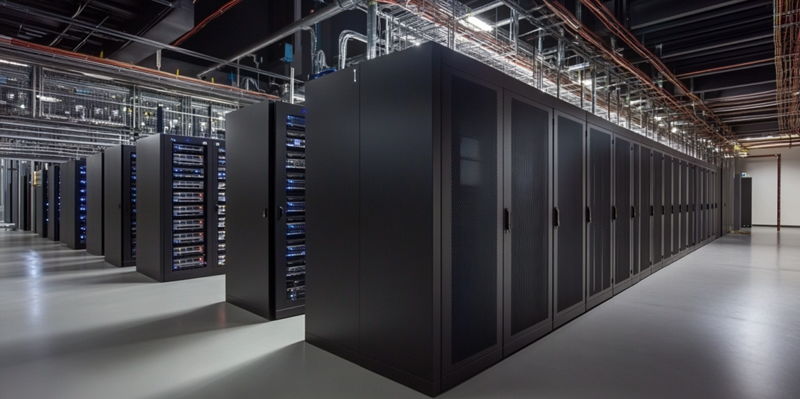As Artificial Intelligence (AI) technology becomes increasingly integral to various business operations, its associated energy demands have caused a significant surge in power consumption and carbon emissions from global data centers. This surge in energy consumption has caused serious environmental concerns, especially regarding the ability of current infrastructures to handle such intense power densities and cooling requirements.
Mark Fenton, Product Engineering Director at Cadence, has emphasized the considerable environmental toll exacted by AI technology, making it clear that the existing data center infrastructures are struggling to meet the rising demands. This significant increase in power consumption is evident in activities such as a single ChatGPT query, which notably uses a lot more electricity compared to a traditional Google search. Furthermore, data centers are also enormous consumers of water, with an average facility using around 300,000 gallons daily. This amount is comparable to the daily water usage of approximately 100,000 homes, which underscores the massive resource drain created by data centers operating at full capacity.
Solutions for Rising Energy Demands
Optimizing Existing Resources
To effectively combat the sustainability challenges inherent in data centers, it’s crucial to move beyond the simplistic approach of merely expanding physical infrastructure. Instead, there’s a pressing need to optimize the current resources at hand to achieve greater efficiency and reduce environmental strain. In this vein, Mark Fenton has introduced the innovative concept of digital twin technology as a promising solution. Digital twins are virtual replicas of data centers, enabling operators to enhance power management and cooling efficiencies in transformative ways.
By creating these sophisticated virtual models, operators can simulate various operational scenarios within the data center, allowing them to experiment in a risk-free environment. This method helps to uncover the least amount of energy required to maintain operational effectiveness without incurring real-world consequences. As a result, digital twin technology stands out as a scalable solution that offers a pragmatic approach to understanding and addressing power usage within data centers, which, consequently, could set the stage for more sustainable AI advancements.
Moreover, adopting digital twins can have significant long-term benefits. It allows data centers to remain adaptive and responsive to evolving AI demands while continually optimizing their energy consumption patterns. This proactive approach not only contributes to reducing carbon footprints but also helps in minimizing the operational costs associated with high-energy demands. Therefore, the strategic use of such technologies signals a forward-thinking shift towards achieving sustainability without hampering the pace of AI innovation and growth.
Balancing AI and Environmental Sustainability
Fenton underscores the ethical imperative of finding a balance between advancing AI technologies and ensuring environmental sustainability. He stresses that while AI technology promises numerous advancements across various sectors, it must not come at the cost of exacerbating environmental harm. This calls for an approach where innovative technologies are leveraged responsibly, and developments such as digital twins are utilized to mitigate environmental impacts effectively.
The notion of prioritizing data center efficiency is crucial, as this ensures that the push for innovation does not compromise environmental goals. For instance, strategic adoption of digital twins can help in achieving an equilibrium where AI technologies continue to flourish without overwhelming current infrastructures or causing undue strain on natural resources. It’s essential to recognize the broader implications of AI innovations and adopt practices that align with long-term sustainability objectives.
Additionally, a balanced perspective on AI and environmental sustainability requires industry-wide collaboration and policy support. Data centers, tech companies, and policymakers must work together to establish frameworks that promote energy efficiency, resource conservation, and overall environmental stewardship. By fostering a culture of responsibility and sustainability, the tech industry can play a pivotal role in mitigating the adverse environmental effects of AI technologies.
Future Outlook for Data Centers
Industry Trends and Developments
The current dilemma facing data centers encapsulates the collision of rapid AI innovation with the pressing need for sustainability. Key trends include the surging power and water demands of AI applications and the increasing significance of optimizing existing infrastructures. The potential of digital twin technology to transform data center operations provides an exciting glimpse into the future of sustainable technology development.
To push the boundaries further, the global tech industry must embrace a cohesive, multi-faceted approach to sustainability. This means integrating renewable energy sources, investing in energy-efficient hardware, and continually refining cooling and power management through digital twins and other cutting-edge technologies. Each step taken towards enhancing efficiency brings the sector closer to a harmonious balance between technological growth and environmental responsibility.
It’s imperative to embed sustainability at the core of data center design and operation. Future data centers should prioritize minimal environmental footprints while delivering high performance. The inclusion of AI in predictive maintenance and resource management can significantly cut down waste, thereby fostering an ecosystem where both innovation and sustainability are equally prioritized. Through such measures, it’s possible to sustain the momentum of AI development without succumbing to the detrimental impact on the planet.
Strategic Tech Integration
As Artificial Intelligence (AI) technology becomes increasingly essential to various business operations, its escalating energy demands have led to a significant rise in power consumption and carbon emissions from global data centers. This dramatic increase in energy use presents serious environmental concerns, particularly the capacity of current infrastructures to manage the heightened power densities and cooling requirements.
Mark Fenton, Product Engineering Director at Cadence, has pointed out the substantial environmental impact of AI technology, emphasizing that existing data center infrastructures are struggling to meet these growing demands. The marked rise in power usage is evident in activities like a single ChatGPT query, which consumes considerably more electricity than a traditional Google search. Additionally, data centers are vast consumers of water, with an average facility using approximately 300,000 gallons daily. This amount is comparable to the daily water consumption of around 100,000 homes, highlighting the significant resource drain imposed by data centers operating at full throttle.

